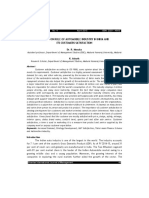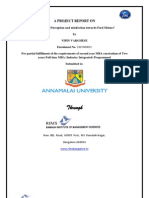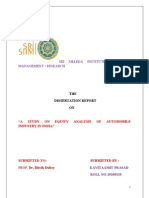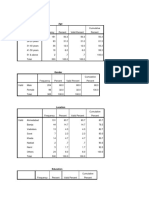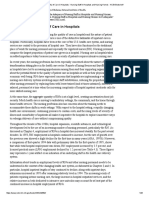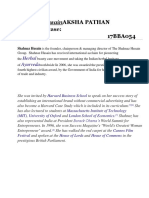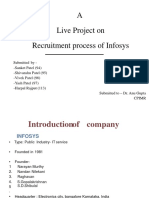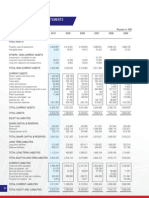Project Report On Commercial Vehicles Industry
Project Report On Commercial Vehicles Industry
Uploaded by
VivekCopyright:
Available Formats
Project Report On Commercial Vehicles Industry
Project Report On Commercial Vehicles Industry
Uploaded by
VivekOriginal Title
Copyright
Available Formats
Share this document
Did you find this document useful?
Is this content inappropriate?
Copyright:
Available Formats
Project Report On Commercial Vehicles Industry
Project Report On Commercial Vehicles Industry
Uploaded by
VivekCopyright:
Available Formats
1
Project Report
On
Commercial Vehicles
Industry
CONTENTS
Preface
Executive Summery
Acknowledgement
Evolution and Growth of Industry
Market Size of Industry
Product Mix of Commercial Vehicle Industry in India
Competitive Analysis
Outlook
Declaration
Bibliography
PREFACE
Master of Business administration is a course, Which combines both theory and its applications
as its contents of study in the field of management. As part and parcel of thiscourse, every
aspirant has to prepare Market Research Report on particular Industry .The purpose
of this report is to get the in depth knowledge regarding the Industry and enhance students
analytical skills. One of the Indian booming Indian commercial vehicle industry which is
being researched byour group from the management perspective. By studying Indian commercial vehicle
industryfrom a management perspective we would be able analysis potential opportunity as well
asthreats of the commercial vehicle industry. Also, attractiveness of new entrant
would be analysis with the help of Michael Porters five force model. Environmental scanning
would be with the help of PEST analysis (Political, Economic, Social and technology).
The data for analysis is being collected through the secondary sources like internet, Newspaper and published journal.
EXECUTIVE SUMMERY
This report is the study of Indian commercial vehicles industry. This report has helped us
togetting some very useful insight of the commercial vehicles industry. Tata Motor, Eicher
Motor, Mahindra & Mahindra,Swaraj Mazda are the dominant player of the Indian commercial
vehicle Industry. India is 13th largest commercial vehicle market in the world. The last five years
industry has grown CAGR of 14%. Commercial vehicles Industrys sharein Indian automobile is
5.05% in the year 2007-08.T h e i n d u s t r y w h i c h g r e w a t a r a t e o f a b o v e 2 5 % o v e r
2 0 0 1 - 0 7 h a s g r o w n b y j u s t 5 % i n F Y 2 0 0 8 , so the economic fluctuation
affect greatly to Indian commercial vehicle Industry. Ability to enhance and vary
product mix, Sales and distribution service network, Access tonew technologies are the key
success factor of Indian commercial vehicle Industry.An Indian railway is the only one
competitor of Indian commercial vehicle Industry but because of several advantage
commercial vehicle Industry ruled over the Indian railway.
Inn e a r f u t u r e w e a r e n o t s e e i n g a n y s u b s t i t u t e o f c o m m e r c i a l v e h i c l e I n d
u s t r y. I n d i a n commercial vehicle Industry use sales promotional tool as
marketing tool most and for advertisement the print media is preferred by the most of the
Indian players. Here we got chance to understand the fundamentals of Indian commercial
vehicles industryand also identifies the position of the industry, that how they had
built its image in themarket.
ACKNOWLEDGEMENT
I take this opportunity to express my deep sense of gratitude to those who have contributed
significantly by sharing their knowledge and experience in the competition of this project work.
I am greatly obliged to, for providing me with the right kind of opportunity and facilities to
complete this venture.
I am highly thankful to Mr., my faculty under whose able guidance this project work was carried
out. I thank him for his continuous support and mentoring during the tenure of the project
.Finally, I would also like to thank to all my dear friends for their cooperation, advice and
encouragement during the long and arduous task of carrying out the project and preparing this
report.
Evolution and Growth of Industry
A Nations economy is well known from its transport system for instant and rapid growth in
economy, a well-developed and well-networked transportation system isessential. As India's
transport network is developing at a fast pace, Indian AutomobileIndustry is growing too. Also,
the Automobile industry has strong backward andforward linkages and hence provides
employment to a large section of the population. Thus the role of Automobile Industry is very
essential in Indian economy. Varioustypes of vehicles are manufactured by the Automobile
Industry. Indian Automobile Industry includes the manufacturing of trucks, buses, passenger cars, defense
vehicles, two-wheelers, etc.
The industry can be broadly segmented into the following category :-
Commercial Vehicle (CV) industry in India has surged over the past decade and the market is
expected to grow at a CAGR of over 15% until 2016 (Source: Society of Indian Automobile
Manufacturers (SIAM)) with many companies competing to expand. Commercial vehicle is a
type of motor vehicle that is used for transporting goods or carrying passengers with former
contributing around 87% in India. Commercial vehicles are classified into Light, Medium &
Heavy depending upon its gross vehicle weight. The CV industry enables quick, easy departure
of goods and accepts smaller loads than railways and also commercial vehicles can access
remote and hilly areas where rail lines cannot be constructed.
The main growth drivers for CV Industry are modernization of the trucking industry, structural
shift to Hub & Spoke model, improved road infrastructure, growing freight capacity and increase
in exports from remote areas enabling the producers/manufacturers to move their goods to ports.
The key risk factors for this industry are low freight demand and truck rentals, non-availability of
cargos, fuel price, risk prone area of occupation, sudden transport strike, competition with
alternate mode of transport (Railways) and any new government regulations related to
restrictions based on age of the vehicle and other environmental safety issues. Also, recent study
on CV industry by ICRA found that the Indias GDP and IIP numbers are very closely correlated
with the development of Commercial Vehicle Industry, which in turn has made this industry the
lifeline of Indian Economy.
CV Financing and Securitisation
CV Financing Industry in India has seen an impressive growth and in the last five years till 201213, CV loan disbursements grew by around 11 per cent (Source: CRISIL Research, Retail
Finance- Auto, June 2013). Major players in CV Financing in India are Tata Motors
Cholamandalam Finance, Sundaram Finance, AU Finance, Shriram Transport Finance, Magma,
L&T, M&M and Religare. The key factors that could impact vehicle financing in India are
growth in vehicle sales, finance penetration and average ticket size (players offering marginally
higher LTV because of competition from other players). The process of pooling the loans given
by these CV financiers and selling the securities backed by cash flows from the loans to investors
is termed as Securitization of CV pools and the bank or finance company that has originated the
pool of receivables/loans is termed as Originator. While selecting the loans for securitization,
Originator should take into account the factors such as loan tenure, Interest rates, vehicle type
(LCV/UCV), geographical diversity, recovery rates, etc.
Growth of the industry is taking place in clusters. The automotive industry is developing in
clusters. There are four major clusters in the automotive industry in India. They are in and
around New Delhi, Gurgaon and Manesar in North India, Pune, Nasik, Halol and Aurangabad in
West India, Chennai, Bangalore and Hosur in South India and Jamshedpur and Kolkata in East
India. Of course there are several manufacturing units in many other parts of India but these four
clusters are expected to become the main hubs for manufacturing in the automotive industry. The
Government of India (GOI) is taking initiatives to develop the automotive clusters. For example,
the GOI, in its 11th Five Year Plan (20072012), is planning to create the Specialized Education
and Training Institute for the automotive industry. It is also taking measures to enhance
transportation, communication, and infrastructure facilities in these clusters.
After a few years of strong growth, Indias commercial vehicle (CV) industry hit a rough patch
last year, impacted by the overall
economic slowdown, delay in infrastructure projects and weak investment sentiment. However,
the industry has long-term growth
potential, subject to the economy accelerating back to 7%8% GDP growth per annum and the
Government expediting policies that
support growth of manufacturing and infrastructure development. While deregulation of diesel
prices will make the industry less
dependent on subsidies, it is likely to create demand uncertainty in the short-term as truck
owners and manufacturers adjust to the new normal.
Market Size Of Industry
Industry performance in 2011-12
Production
The cumulative production data for April-March 2012 shows production growth of 13.83 percent
over same period last year. In March 2012 as compared to March 2011, production grew at a
single digit rate of 6.83 percent. In 2011-12, the industry produced 20,366,432 vehicles of which
share of two wheelers, passenger vehicles, three wheelers and commercial vehicles were 76
percent, 15 percent, 4 percent and 4 percent respectively.
Domestic Sales
The growth rate for overall domestic sales for 2011-12 was 12.24 percent amounting to
17,376,624 vehicles. In the month of only March 2012, domestic sales grew at a rate of 10.11
percent as compared to March 2011.
Passenger Vehicles segment grew at 4.66 percent during April-March 2012 over same period last
year. Passenger Cars grew by 2.19 percent, Utility Vehicles grew by 16.47 percent and Vans by
10.01 percent during this period. In March 2012, domestic sales of Passenger Cars grew by 19.66
percent over the same month last year. Also, sales growth of total passenger vehicle in the month
of March 2012 was at 20.59 percent (as compared to March 2011). For the first time in history
car sales crossed two million in a financial year.
The overall Commercial Vehicles segment registered growth of 18.20 percent during AprilMarch 2012 as compared to the same period last year. While Medium & Heavy Commercial
Vehicles (M&HCVs) registered a growth of 7.94 percent, Light Commercial Vehicles grew at
27.36 percent. In only March 2012, commercial vehicle sales registered a growth of 14.82
percent over March 2011.
Three Wheelers sales recorded a decline of (-) 2.43 percent in April-March 2012 over same
period last year. While Goods Carriers grew by 6.31 percent during April-March 2012, Passenger
Carriers registered decline by (-) 4.50 percent. In March 2012, total Three Wheelers sales
declined by (-) 9.11 percent over March 2011.
Total Two Wheelers sales registered a growth of 14.16 percent during April-March 2012.
Mopeds, Motorcycles and Scooters grew by 11.39 percent, 12.01 percent and 24.55 percent
respectively. If we compare sales figures of March 2012 to March 2011, the growth for two
wheelers was 8.27 percent.
Exports
10
During April-March 2012, the industry exported 2,910,055 automobiles registering a growth of
25.44 percent. Passenger Vehicles registered growth at 14.18 percent in this period. Commercial
Vehicles, Three Wheelers and Two Wheelers segments recorded growth of 25.15 percent, 34.41
percent and 27.13 percent respectively during April-March 2012. For the first time in history car
exports crossed half a million in a financial year.
In March 2012 compared to March 2011, overall automobile exports registered a growth of
17.81 percent.
11
12
13
14
PRODUCT MIX OF COMMERCIAL VEHICLE INDUSTRY IN
INDIA
AMBULANCE:
Ambulance forms the important category of commercial vehicle. The sole purpose of this
vehicle is to carry the sick and injured persons. Modern-day ambulances are typically
large automobiles on a van or light truck chassis with a maximum road weight up to 7.5
tonnes.
They are categorized into various sub-categories such as Emergency ambulance, Patient
Transport Ambulance, Response Unit and Charity Ambulance depending on their
functional use.
The major producers of these vehicles areForce Motors
Traveller Ambulance
Hindustan Motors Ltd
RTV Ambulance
Mahindra & Mahindra Ltd.
Mahindra Voyager Ambulance
Mahindra MM 540 DP Ambulance
Maruti Suzuki India Ltd.
Omni Ambulance
Swaraj Mazda
Swaraj Mazda Ambulance
Tata Motors
Tata Winger
TRUCKS:
Trucks are basically used for carrying goods and materials in bulk. These trucks are
classified into sub-categories like depending on their size and functional use: haulage,
rigid trucks, tippers, cabs, delivery vans and trailers. They come under the intrinsic
15
category of vehicle due to India's growing commercial sector. The fuel efficiency of these
vehicles has also improved to a great extent in the past few years.
The major players of truck manufacturers in India are:
Ashok Leyland
Haulage :
4x2 Haulage Models
1613 H
1612 H
Comet 1611
1613H/2 (12M Goods)
4/51GS
1613 S
1616 H
1616H - BS III
Hippo Haulage
Multiaxle Vehicles
2214 (6X2)
2516 H (6X2)
2514 H (6X2)
2516 H (6X 4)
2516H/4C
Beaver Haulage
Tippers :
Hippo Tipper
4x2 and Multixled Tippers
CT 1613 H/1 (4X2)
Taurus 2516/2 (6x4)
1613 ST (4x2)
Taurus HD 2516MT/1 (6x4)
CT 1613 H/2 (4x2)
Stallion Mk III Tipper
Rigid Trucks :
Beaver Tractor
Ecomet
Ecomet 912
Ecomet 1112
Hippo Tractor
Force Motors
Haulage :
CLA 40.280
CLA 49.280
Hindustan Motors Ltd.
Rigid Trucks :
Mascot T-480 FC
Porter Plus
Pick-Up
Mahindra & Mahindra Ltd.
Cabs :
Pic-Up Range
Mahindra Utilty
Mahindra Pik-up
Mahindra NC640DP
Hard Top Range
Mahindra Economy
Mahindra Marshal DI
Mahindra 775 XDB
Cargo
16
Pik-Up CBC
Mahindra 3door Hard Top
Mahindra 5door Hard Top
LCV Range
Mahindra CabKing 576
Mahindra DI 3200
Mahindra Cab King 576 DI
Mahindra Load King DI
Maxx Maxi Truck
Delivery Van
Mahindra Voyager Delivery Van
Swaraj Mazda
Rigid Trucks :
Swaraj 4 Wheel
Drive
Sartaj V W 26-S
Applications
Premium Truck
Super ZT54
Swaraj Mazda Water Tank
Tata Motors
Rigid Trucks :
Tata Motors' Range of
'World Trucks'
Tata Ace
Rigid Trucks
Tata Novus
LPT 1109 Turbo Truck
LP 1109 Turbo Truck
TL 4x4
SFC 407 Ex Turbo Truck
SFC 407 Turbo Truck
LPT 709 E Truck
LPT 407 Turbo Truck
SFC 709 E Aerial Lift Turbo
Truck
Pic-Up
Tata Xenon XT
Volvo
Rigid Trucks
Volvo FM
Tippers
Volvo FM9 Tippers
FM400 8x4 Tipper
M340 6x4 Tipper
Volvo FH
17
TRACTORS:
Tractors are heavy vehicles serving the purpose of hauling at an extremely low speed.
India being one of the major agricultural countries makes the use of tractors on a large
scale. It is one of the heaviest vehicle basically used for carrying out the agricultural
tasks in an effective way. Modern tractors usually employ diesel engines which delivers
18 to 575 horsepower
The major producers of tractors in India are:
Escorts Ltd.
Farmtrac
Farmtrac 45
Farmtrac 50
Farmtrac 60
New Farmtrac 70
Powertrac
Powertrac
Powertrac
Powertrac
Powertrac
430
435
440
455
Force Motors
Balwan
Balwan
Balwan
Balwan
Balwan
OX 25
Tractor
300
400
450
500
Swaraj
Swaraj
Swaraj
Swaraj
Swaraj
Swaraj
Swaraj
Swaraj
Swaraj
Tractor
722 Super
724 FE
733 FE
735 FE
744 FE
834 FE
855
939 FE
Swaraj Enterprise
Swaraj
Swaraj
Swaraj
Swaraj
Swaraj
Forklift Tractors
EL. Forklift 15
Forklift 15
Forklift 20
Forklift 30
Swaraj Harvester Combine
Sonalika Tractors
DI
DI
DI
DI
DI
DI
DI
DI
DI
DI
35
60 2WD
60 Senior
75 4WD
340 S
730 III
735
740 III
750
750 III
DI
DI
DI
DI
DI
DI
DI
DI
DI
55
60 4WD
75 2WD
90 4WD
730 II
732 III
740
745 III
750 II
Mahindra Kisanmitra
18
Mahindra Arjun
Arjun 445 DI
Arjun 605 DI
Mahindra Bhoomiputra
Bhoomiputra 265 DI
Bhoomiputra 275 DI TU
Bhoomiputra 475 DI
Bhoomiputra 575 DI
Mahindra Yuvraj
Arjun 555 DI
Mahindra Sarpanch
Sarpanch 265 DI
Sarpanch 275 DI TU
Sarpanch 475 DI
Sarpanch 585 DI
Sarpanch 575 DI
Sarpanch 595 DI Super Turbo
HMT Tractors
HMT Yuva
2522 OS
3522 DX
4022
4922 DX
7511
2522 FX
3522 CS
3522 FX
4922
6522
Tafe Tractors
MF 241 Eagle
MF 1035 Std.
Tafe 25 DI
TAFE 4410 Samrat
Tafe 8502 - 4WD
MF 1035 DI
MF 5245 Mahaan
Tafe 30 DI
Tafe 5900 DI Gajraj
Indofarm Tractors
Indo Farm 2030 DI
Indo farm 2040 DI
Indo farm 2035 DI
Indo farm 2050 DI
BUSES:
A bus is a huge commercial vehicle, said to have originated in France in the year 1826 by
StanislasBaudry under the name of 'Omnibus'. The basic purpose of this vehicle is to carry
the passengers as it is an easy and cost-effective medium of transport.
The major producers of buses in India are Ashok Leyland and Tata Motors whereas Swaraj
Mazda and Hindustan Motors have made a big name in manufacturing mini-buses.
However there are huge sub-categories of buses like-Commuter Bus, School buses,
Electric buses and so on. In India,CNG buses have occupied the huge market thus making
it an fuel efficient and environmental friendly vehicle.
The major players in this sector are:
19
Ashok Leyland
Airport Tarmach
Coach
Double Decker
Stag-BS II
Cheetah BS-II
Lynx BS-II
Vestibule Bus
Viking BS-III
12-M Bus-II
Viking CNG BS-III
12-M Bus
Cheetah BS-III
Panther BS-II
Viking BS-II
Viking SLF BSIII
Eicher
Skyline Bus
Skyline CNG Bus
School Bus
Cruiser
Force Motors
Citiline 25+D
Traveller Mini Bus
14 +D
Citiline School Bus (25+D)
Commuter
32+D
Traveller Long 17+D
Hindustan Motors Ltd.
RTV Custom
RTV Passenger
RTV School
Bus
Mahindra & Mahindra Ltd
Mahindra FJ
Minibus
Mahindra FJ 470
Tourister 15
Swaraj Enterprise
Bus
School Bus
CNG Bus
Tata Motors
Starbus
StarbusSkool
StarbusSkool 17
StarbusSkool 32
StarbusSkool 52
Starbus Low Floor
Starbus LF
Starbus ULF CNG
Starbus Standard
Starbus 16
Starbus 18 CNG
Starbus 20
Other Buses
SFC 407 Turbo Mini-Bus
LPO 1510 CGS Bus (CNG Bus)
LP / LPO 1510 Bharat stage II Bus
LPO 1616 TC Luxury Bharat
Stage - II Bus
Globus
Globus 13
Globus 18
Globus 20
Globus 45
LHD Bus
20
Starbus 32
Starbus 54
Starbus 67
Starbus Deluxe
StarbusDlx 18
StarbusDlx 20
StarbusDlx 28
StarbusDlx 35
Competitive Analysis
Two decades ago, India opened its doors for multinational automobile companies allowing them
topenetrate the market, modernize the Indian transportation picture and make it beneficial for the
end-users.
The India Commercial Vehicle Market Analysis observed that the commercial vehicle segment
of the Indianautomobile industry has shown great recovery after withstanding the effects of the
global economic crisis.With economic revival, increasing public & private spending on
infrastructure and higher penetration offinancing facilities, we expect the growth trend in each
segment of commercial vehicles to continue in thecoming years. As per our analysis, LCV goods
carrier is the fastest growing segment that is estimated toregister a sales growth of around 20%
during FY 2012-FY 2015.
Our report has studied the Indian commercial vehicle market from various perspectives. It
facilitatesinformation on production, sales, exports and key players in each segment (M&HCV,
LCV and threewheelers)that has been further divided into passenger carrier and goods carrier
sections. A comprehensivestudy on commercial vehicle tyre has also been included in the
extensive research, which also foreseesgrowth in CV auto component industry.
We observed that hub and spoke model and small commercial vehicles are among the major
trends whichwould drive the Indian CV market in near future. During the regional analysis, it
was found that South Indialeads the country in terms of commercial vehicle market. Besides, the
growth in the CV industry will boostup demand for used commercial vehicles in coming years.
With a view to understanding the industry's competitive landscape and presenting its balanced
outlook toclients, we have included profiles of key players like Tata Motors and Ashok Leyland
in our research study.
21
MAJORPLAYERSOFINDIANCOMMERCIAL VEHICLE INDUSTRY
22
Mahindra & Mahindra (M&M):
M&M is the dominant player in multi utility vehiclesegment. In UV market The Company has
around 51% market share in FY08. M&M has amarket share of 11.2% in C-segment cars during
FY08. M&M is second biggest player in theIndian LCV segment. The company has recently
announced an investment of Rs 15 billion inthe upcoming Greenfield Chakan facility in Pune. It
plans to use the capacity for the production of LCV, M&HCV and UV at this plant with the
initial capacity of around 2.5 lakhunits.
ASHOK LEYLAND
Ashok Leyland (ALL): ALL is the second-largest commercial vehicles manufacturer
in India.The company plans to increase the installed capacity from 84,000 vehicles in FY08
to184,000 vehicles by FY10 with a capital expenditure of Rs 30 billion over the next threeyears.
Nissan Motor and ALL have stepped up planned investment in their three new jointventure
companies to $575 million. The JV will set up manufacturing capacity of one lakhvehicles in the
first phase which would be scaled up subsequently. The plant is expected tostart production by
FY10-11
Tata Motors
Tata Motors (TML): TML is the worlds fifth largest and Indias largest medium and
heavycommercial vehicle manufacturer. The company has plants in Jamshedpur, Pune, Lucknow,
andDharwad and R&D centers in Pune, Jamshedpur, and Lucknow in India and in South Korea,
Spain and the UK. The company markets its products in Europe, Africa, Middle East, South
Asia, South East Asia and Australia. Tata Motors has planned a capacity of 2.25 lakh units
for Ace, the sub-one-tonne truck, while the existing capacity in Pune is just around 60,000 units
a year. Recently, TML has acquired Jaguar and Land Rover from Ford Motors for $2.3 billion.
23
Eicher Motors (EML):
EML produces commercial vehicles including trucks, buses, motorcycles, automotive gears and
components. The company has sold 8.1% of promoters holding to Swedish bus maker Volvo to
form a joint venture, in which Volvo will pump upRs 1,082 crores. The JV would be a subsidiary
of
EML,
where
Eicherwould
hold
54.4%equity and Volvo 45.6%. The manufacturing facility of Eicher Motors is located inPithamp
ur, Madhya Pradesh. The plant houses some top-of-the-line equipments, a robust infrastructure
and has an annual production capacity of 30,000 vehicles. The company is one of the leading
manufacturers of commercial vehicles in India with a 33% market share in the7T-11T segment.
Eicher motor is another leading company in commercial vehicle Industry although we
cannotcompare it with Tata motor as EMLs market share is not more than 10% in any segment
of Indian commercial vehicle industry. Eicher motors highest market share in medium andheavy
commercial vehicle segment it has 9 % market share in multi and heavy goods carrier.
24
Outlook
Growth:
although rise in interest rates and fuel price may dampen the growth of the sector in short run and
long run:term outlook for the domestic cv industry remains strong. The expectedcontinuance of economic
growth and investments in infrastructure will help the sector report r o b u s t g r o w t h g o i n g
forward. the entry of new players in the industry and the
s i g n i f i c a n t capacity additions expected are however likely to keep the competitive pressures
high. on thed e m a n d s i d e , a c o m b i n a t i o n o f t i g h t e n i n g r e g u l a t o r y n o r m s ( o n
emissions and vehicle scrapping) and increasing customer selectivity is
e x p e c t e d t o d r i v e a s h i f t t o w a r d s h i g h tonnage quality products. The top players
in the domestic cv industry have robust financials, s u p p o r t e d b y s t r o n g c a s h a c c r u a l s
a n d a c o m f o r t a b l e c a p i t a l s t r u c t u r e . T h e s e p l a y e r s a r e capable of funding their
significant investment plans over the medium term without resorting t o a n y l a r g e
borrowings. Moreover, the ongoing capacity expansions are based
l a r g e l y o n outsourcing models, which aim at better sharing of risks with component suppliers
and lower the break-even levels. The significant export drives being made by the leading cv
players are likely to lower the risks arising from concentration on the domestic market and
mitigate the impact of cyclical downturns to an extent
25
Rising commercial vehicle loan defaults increase risk for lenders
The inevitable fallout of the long decline in commercial vehicle (CV) sales is the rise in
delinquencies in loans to this sector. Prolonged sluggishness in the economy along with high
interest rates has led to defaults of commercial vehicle loans. Obviously, this puts at risk the nonbanking finance firms, which have a reasonably high exposure to this segment.
A report by India Ratings and Research Pvt. Ltd says that for the quarter ended September, the
weighted average of 90-plus days dues rose by 23% from the immediate preceding quarter to
3% of the loans. An earlier report by Equifax Credit highlighting the 30-day outstanding loan
delinquencies were up by about 18% in the first half of fiscal year 2013.
The data is backed by the corporate results of leaders in CV lending. Shriram Transport
Finance Co. Ltd reported a margin decline, albeit a small one, compared with the June quarter,
mainly due to high cost of borrowing, growth moderation in assets under management and
inching up non-performing assets. Non-banking financial companies in this segment like
Cholamandalam Investment and Finance Co. Ltd and Sundaram Finance Ltd have reduced
the loan amount given as a percentage to value of the asset and tightened eligibility norms.
But risks on existing assets continue to rise. A report from Antique Stock Broking Ltd points
out some worrisome trends in the industry. Utilization of trucks has fallen as number of trips per
month has come down to six from 10, with no return trip. This has strained cash flows of
transporters. Delay in payment of loan instalments has spread from heavy trucks to even
intermediate and light CVs.
The deteriorating fundamentals of finance firms are due to all-round sluggishness in the
economy, ranging from agricultural product movements to industrials, mining and infrastructure.
More worrisome is the recently noticed trend of rise in early delinquency rate against a
scenario of stable repayment of loans at least in the first two to three years. The handful
of listed firms has shown stress on cash flows in the last several quarters, which is
unlikely to improve immediately, in spite of improved collection procedures and lending
norms.
Meanwhile, year-till-date sales volume of trucks is down 27% compared with a year ago
for Ashok Leyland Ltd and Tata Motors Ltd.
A rise in truck rentals, which has been falling for many months, will bring hope. A 3-4%
rise in truck rentals seen in the last two months, however, could be due to arrival of the
agricultural harvest. This is too early to signal a revival.
26
BIBLIOGRAPHY
http://www.icra.in/Files/ticker/SH-2013-Q1-1-ICRA-Commercial%20Vehicles.pdf
http://www.indiacommercialvehiclesummit.com/
http://www.ey.com/IN/en/Newsroom/News-releases/PR_Mega-trends-shaping-theIndian-commercial-vehicle-industry
You might also like
- Project Report On Commercial Vehicles IndustryDocument26 pagesProject Report On Commercial Vehicles IndustryMansi Prashar0% (2)
- VANSHIKA Industry Overview - Automobile - DraftDocument18 pagesVANSHIKA Industry Overview - Automobile - DraftKinshuk AcharyaNo ratings yet
- Dissertation On Automobile Industry in IndiaDocument6 pagesDissertation On Automobile Industry in IndiaCustomPaperWritingSingapore100% (1)
- Auto MobileDocument44 pagesAuto MobileSanjay PatelNo ratings yet
- Project On (Tata Motors)Document61 pagesProject On (Tata Motors)SATYABRAT MAHALIK100% (1)
- Pinki Project ReportDocument63 pagesPinki Project ReportRaja KumarNo ratings yet
- Indian Supply Chain ScenarioDocument3 pagesIndian Supply Chain Scenariojhbalaji100% (1)
- FM Admin 3Document39 pagesFM Admin 3muditNo ratings yet
- A Study On Role of Automobile Industry in India and Its Customers SatisfactionDocument12 pagesA Study On Role of Automobile Industry in India and Its Customers Satisfactionyounusmohammed117No ratings yet
- Porter's Five Forces Analysis - Indian Automobile Industry: 1. The Threat of New EntrantsDocument33 pagesPorter's Five Forces Analysis - Indian Automobile Industry: 1. The Threat of New Entrantsneha4301No ratings yet
- Automobile Industry and PerformanceDocument5 pagesAutomobile Industry and PerformanceChetan PatelNo ratings yet
- Indian Automotive Industry: Expectation Survey 2014Document32 pagesIndian Automotive Industry: Expectation Survey 2014Sandeep MauriyaNo ratings yet
- Buying Behavior Towards Big Car-Project ReportDocument72 pagesBuying Behavior Towards Big Car-Project ReportpujanswetalNo ratings yet
- Automobiles Industry in IndiaDocument79 pagesAutomobiles Industry in India2014rajpoint0% (1)
- Ashok Leyland FinalDocument45 pagesAshok Leyland FinalsmitaNo ratings yet
- Somiya Mam Ashish Kumra Ashutosh Vajpayee Manas Sighal Pratyush Kumar Shobna VermaDocument48 pagesSomiya Mam Ashish Kumra Ashutosh Vajpayee Manas Sighal Pratyush Kumar Shobna Verma9431369017No ratings yet
- Portfolio Analysis Commercial VehiclesDocument25 pagesPortfolio Analysis Commercial Vehiclesroguemba100% (1)
- Chapter 3Document16 pagesChapter 3Kanoj AcharyNo ratings yet
- Mini ProjectDocument22 pagesMini ProjectAshutosh PandeyNo ratings yet
- Advertising Strategies at Chandrashilp Motors Shah Hyundai Santosh 3La18Mba13Document65 pagesAdvertising Strategies at Chandrashilp Motors Shah Hyundai Santosh 3La18Mba13avinash shendreNo ratings yet
- Summer Training Project: "Consumer Buying Behavior Towards Mahindra Scorpio."Document61 pagesSummer Training Project: "Consumer Buying Behavior Towards Mahindra Scorpio."Anil BatraNo ratings yet
- Automobile Industies IndiaDocument4 pagesAutomobile Industies IndiaSharath RaoNo ratings yet
- Case Study Report - 22MBAB35Document50 pagesCase Study Report - 22MBAB35varshini vishakanNo ratings yet
- A Project Report On Ford MotorsDocument77 pagesA Project Report On Ford Motorsvipin88614No ratings yet
- Customer S Satisfaction of Honda Two WheelersDocument58 pagesCustomer S Satisfaction of Honda Two WheelersAbhinash KanigelpulaNo ratings yet
- Auto Industry: Growth Drivers of Indian Automobile MarketDocument5 pagesAuto Industry: Growth Drivers of Indian Automobile Marketbipin3737No ratings yet
- Financial Analysis of Maruti Suzuki, Tata Motors and Mahindra and MahindraDocument7 pagesFinancial Analysis of Maruti Suzuki, Tata Motors and Mahindra and MahindraGarry Josan100% (1)
- MKT PRJDocument30 pagesMKT PRJSandeep SinghNo ratings yet
- Industrial Data: Group: 2Document17 pagesIndustrial Data: Group: 2Elle7loboNo ratings yet
- ASHOK LEYLAND - Summer Internhip ReportDocument57 pagesASHOK LEYLAND - Summer Internhip Report22mba221No ratings yet
- Birla Institute of Technology and Science Pilani: Automobile Sector in IndiaDocument16 pagesBirla Institute of Technology and Science Pilani: Automobile Sector in Indiaਸਚਿਨ ਸੋਨੀNo ratings yet
- A STUDY On EQUITY ANALYSIS of Automobile Industry in IndiaDocument91 pagesA STUDY On EQUITY ANALYSIS of Automobile Industry in IndiaTemp Cad63% (8)
- Q 12 MarketingDocument11 pagesQ 12 Marketingprayas sarkarNo ratings yet
- Literature Review On Automobile Industry in IndiaDocument4 pagesLiterature Review On Automobile Industry in Indiaea59j0hqNo ratings yet
- Maruti - Customer Care ProgramsDocument131 pagesMaruti - Customer Care Programssahil_ahuja_10No ratings yet
- Autoindustryindia2011 111018051453 Phpapp01Document15 pagesAutoindustryindia2011 111018051453 Phpapp01mithai1985No ratings yet
- Industry Report - Non-Commercial VehicleDocument12 pagesIndustry Report - Non-Commercial VehicleSanath SunnyNo ratings yet
- A STUDY On EQUITY ANALYSIS of Automobile Industry in IndiaDocument91 pagesA STUDY On EQUITY ANALYSIS of Automobile Industry in IndiaNeetu Dwivedi100% (4)
- Consumer Behavior and Effect of Marketing Strategy On Atul Autofinal-1Document58 pagesConsumer Behavior and Effect of Marketing Strategy On Atul Autofinal-1rutvik080808No ratings yet
- Car Market in India - KPMGDocument36 pagesCar Market in India - KPMGAvinash VermaNo ratings yet
- Brochure Passenger VehicleDocument2 pagesBrochure Passenger VehiclePrasad NaikNo ratings yet
- Final Capstone ProjectDocument112 pagesFinal Capstone ProjectJignesh Shingala50% (2)
- ACMA Annual Report 2011-2012Document92 pagesACMA Annual Report 2011-2012Siddh MehtaNo ratings yet
- Bentley SDMDocument34 pagesBentley SDMramramjirockyNo ratings yet
- A Study On Organisational Culture and It's Impact On Employees' Behaviour in Automobile IndustryDocument4 pagesA Study On Organisational Culture and It's Impact On Employees' Behaviour in Automobile IndustryharshNo ratings yet
- Analysis of Automobile IndustryDocument9 pagesAnalysis of Automobile IndustryNikhil Kakkar100% (1)
- Hyundai CompanyDocument80 pagesHyundai CompanySandeep SinghNo ratings yet
- IAa DRDocument79 pagesIAa DRakshay tapkirNo ratings yet
- SharanDocument62 pagesSharanRaj KumarNo ratings yet
- Auto SurveyDocument40 pagesAuto SurveySeema AgarwalNo ratings yet
- Project Report: "Market Study of All Segments of Car and New Launches" ofDocument78 pagesProject Report: "Market Study of All Segments of Car and New Launches" ofbushraqadriNo ratings yet
- Project Report: "Market Study of All Segments of Car and New Launches" ofDocument78 pagesProject Report: "Market Study of All Segments of Car and New Launches" ofRajesh Gawande100% (2)
- RESEARCH-METHODOLOGY Tata Motors Assignment 1Document15 pagesRESEARCH-METHODOLOGY Tata Motors Assignment 1Subham Chakraborty100% (1)
- Policies to Support the Development of Indonesia’s Manufacturing Sector during 2020–2024: A Joint ADB–BAPPENAS ReportFrom EverandPolicies to Support the Development of Indonesia’s Manufacturing Sector during 2020–2024: A Joint ADB–BAPPENAS ReportNo ratings yet
- Designated Drivers: How China Plans to Dominate the Global Auto IndustryFrom EverandDesignated Drivers: How China Plans to Dominate the Global Auto IndustryNo ratings yet
- Trial Balance: Private Sector Financing for Road Projects in IndiaFrom EverandTrial Balance: Private Sector Financing for Road Projects in IndiaNo ratings yet
- Asia Small and Medium-Sized Enterprise Monitor 2020: Volume III: Thematic Chapter—Fintech Loans to Tricycle Drivers in the PhilippinesFrom EverandAsia Small and Medium-Sized Enterprise Monitor 2020: Volume III: Thematic Chapter—Fintech Loans to Tricycle Drivers in the PhilippinesNo ratings yet
- Review and Assessment of the Indonesia–Malaysia–Thailand Growth Triangle Economic Corridors: Malaysia Country ReportFrom EverandReview and Assessment of the Indonesia–Malaysia–Thailand Growth Triangle Economic Corridors: Malaysia Country ReportNo ratings yet
- Research ProposalDocument16 pagesResearch ProposalVivekNo ratings yet
- Research - Proposal 17PGDM001Document7 pagesResearch - Proposal 17PGDM001VivekNo ratings yet
- Business Legend: A Report OnDocument17 pagesBusiness Legend: A Report OnVivekNo ratings yet
- Factors Affecting The Hotel IndustryDocument12 pagesFactors Affecting The Hotel IndustryVivekNo ratings yet
- Descriptive Test (16MBA025)Document16 pagesDescriptive Test (16MBA025)VivekNo ratings yet
- PlagarismDocument7 pagesPlagarismVivekNo ratings yet
- Tranning Letter FormatDocument9 pagesTranning Letter FormatVivekNo ratings yet
- Impact of Sectoral Lending On Bank's Profitability: A Study On Consumer GoodsDocument44 pagesImpact of Sectoral Lending On Bank's Profitability: A Study On Consumer GoodsVivekNo ratings yet
- A Corporate Research Project: Presented by - Lisha PatelDocument4 pagesA Corporate Research Project: Presented by - Lisha PatelVivekNo ratings yet
- Indukaka Ipcowala Institute of Management, Charotar University of Science and Technology, ChangaDocument11 pagesIndukaka Ipcowala Institute of Management, Charotar University of Science and Technology, ChangaVivekNo ratings yet
- Staffing and Quality of Care in Hospitals - Nursing Staff in Hospitals and Nursing Homes - NCBI BookshelfDocument26 pagesStaffing and Quality of Care in Hospitals - Nursing Staff in Hospitals and Nursing Homes - NCBI BookshelfVivekNo ratings yet
- Report PDFDocument34 pagesReport PDFVivekNo ratings yet
- Learning Dairy-Organization Attachment Programme (OAP)Document3 pagesLearning Dairy-Organization Attachment Programme (OAP)VivekNo ratings yet
- SoleDocument7 pagesSoleVivekNo ratings yet
- O.B.Assignment On Studying Personality Types Through MoviesDocument9 pagesO.B.Assignment On Studying Personality Types Through MoviesVivekNo ratings yet
- Shahnaz Husain: Aksha Pathan Secondary Case: 17BBA054Document28 pagesShahnaz Husain: Aksha Pathan Secondary Case: 17BBA054VivekNo ratings yet
- Recruitment Process of InfosysDocument15 pagesRecruitment Process of InfosysVivek0% (1)
- 10 Files MergedDocument10 pages10 Files MergedVivekNo ratings yet
- Water: Business Plan On Processing of RO Water and Sale For GainDocument26 pagesWater: Business Plan On Processing of RO Water and Sale For GainVivekNo ratings yet
- SoleDocument7 pagesSoleVivekNo ratings yet
- VISION 2020 E-ResourceDocument8 pagesVISION 2020 E-ResourceVivek100% (1)
- Porter's Five Forces Industry Analysis of Indian Passenger Car IndustryDocument11 pagesPorter's Five Forces Industry Analysis of Indian Passenger Car IndustryVivekNo ratings yet
- Negot Iation Skills: Submitted To: Mr. Kaushik Trivedi Submitted By: Vivek Patel (14BBA049)Document12 pagesNegot Iation Skills: Submitted To: Mr. Kaushik Trivedi Submitted By: Vivek Patel (14BBA049)VivekNo ratings yet
- Mukhya Mantri Awas Yojna: A Project OnDocument12 pagesMukhya Mantri Awas Yojna: A Project OnVivekNo ratings yet
- Project 1 KishanDocument24 pagesProject 1 KishanVivekNo ratings yet
- Retaining Talent Is A Huge Challenge For The Economy: Venu SrinivasanDocument2 pagesRetaining Talent Is A Huge Challenge For The Economy: Venu SrinivasanVivekNo ratings yet
- P.O. Box 17198Document3 pagesP.O. Box 17198api-19133071No ratings yet
- Clause 14.2 Advance Payment-Understanding Clauses in FIDIC Conditions of Contract For EPC/ Turnkey Projects' First Edition 1999.Document2 pagesClause 14.2 Advance Payment-Understanding Clauses in FIDIC Conditions of Contract For EPC/ Turnkey Projects' First Edition 1999.Dayal94% (18)
- Bank Modelling ValuationDocument4 pagesBank Modelling ValuationQuofi SeliNo ratings yet
- Jaiib Paper 1 Capsule PDF 2.o PDF PPB by Ambitious BabaDocument282 pagesJaiib Paper 1 Capsule PDF 2.o PDF PPB by Ambitious BabaSaurabhNo ratings yet
- Home Loan KeywordsDocument10 pagesHome Loan KeywordsJames Brent100% (1)
- Comparative Study of Data Reported To The OECD Creditor Reporting System (CRS) and To The Aid Management Platform (AMP)Document38 pagesComparative Study of Data Reported To The OECD Creditor Reporting System (CRS) and To The Aid Management Platform (AMP)anjeshNo ratings yet
- Eduardo Fajardo 11690232 de Barreto, Et. Al. V. Villanueva, Et. Al., (1961)Document20 pagesEduardo Fajardo 11690232 de Barreto, Et. Al. V. Villanueva, Et. Al., (1961)Mark Evan GarciaNo ratings yet
- City Limits Magazine, October 1979 IssueDocument22 pagesCity Limits Magazine, October 1979 IssueCity Limits (New York)No ratings yet
- A Cebuana Lhuillier Branch in Angeles CityDocument2 pagesA Cebuana Lhuillier Branch in Angeles CityitsmenatoyNo ratings yet
- Mortgage Market ExerciseshuDocument2 pagesMortgage Market ExerciseshuaryannnevillafuerteNo ratings yet
- BankingDocument49 pagesBankingRitu BhatiyaNo ratings yet
- Banking Awareness EbookDocument467 pagesBanking Awareness EbookSivaji Haldar50% (2)
- CPN CC Manual PDFDocument6 pagesCPN CC Manual PDFBobby Kazemi79% (38)
- GO ChangeInStampDutyDocument9 pagesGO ChangeInStampDutySANTHOSH SANTHOSHNo ratings yet
- Compilation of Suggested Answers To Theory Questions Set in The Institute'S Examinations MAY, 2010 - MAY, 2017Document51 pagesCompilation of Suggested Answers To Theory Questions Set in The Institute'S Examinations MAY, 2010 - MAY, 2017VenkataRajuNo ratings yet
- Unit 3 NotesDocument12 pagesUnit 3 NotesLakshay DhamijaNo ratings yet
- SEC Consolidated Scale of Fines 05 Nov 2013 (26 Nov 2013)Document124 pagesSEC Consolidated Scale of Fines 05 Nov 2013 (26 Nov 2013)Katrina Ross Manzano100% (4)
- Week 2 Form 1040Document2 pagesWeek 2 Form 1040Linda100% (2)
- Atlas Honda: Analysis of Financial Statements Balance SheetDocument4 pagesAtlas Honda: Analysis of Financial Statements Balance Sheetrouf786No ratings yet
- Daftar Riwayat HidupDocument3 pagesDaftar Riwayat HidupDhawy Al-MarbawyNo ratings yet
- Wall Street Crash 1929Document9 pagesWall Street Crash 1929Adrian MazilNo ratings yet
- Foreign Exchange Management Act, 1999 W.E.F. 2000Document28 pagesForeign Exchange Management Act, 1999 W.E.F. 2000Krishnamurthy KgNo ratings yet
- Riverfront Renewal PlanDocument17 pagesRiverfront Renewal PlanSinclair Broadcast Group - EugeneNo ratings yet
- Judge g3 CivprocDocument64 pagesJudge g3 CivprocJoVic2020No ratings yet
- Contract of PledgeDocument22 pagesContract of PledgeNITUL BORAHNo ratings yet
- Long-Term Bank LoanDocument12 pagesLong-Term Bank LoanAbidah Zulkifli100% (1)
- Nature and Types of CompanyDocument20 pagesNature and Types of CompanyAshutosh PandeyNo ratings yet
- Financial Results & Limited Review Report For Sept 30, 2015 (Standalone) (Result)Document4 pagesFinancial Results & Limited Review Report For Sept 30, 2015 (Standalone) (Result)Shyam SunderNo ratings yet
- Chap 002Document24 pagesChap 002fhoweiofweioNo ratings yet
- Application Form For MSEsDocument5 pagesApplication Form For MSEsSenthil_kumar_palaniNo ratings yet








